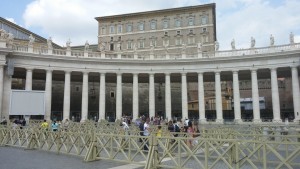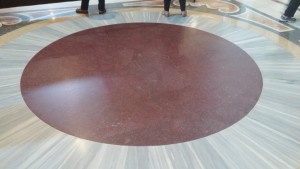On a recent trip to St Peters Basilica and the Vatican Museums I was reminded of the good old days when a visit here was a relaxed and slow visit. These days the numbers of visitors has exploded with new middle class travelers from China, India, and Eastern Europe. A guided visit through the museum is a crowd gauntlet one must endure to get to the prize of the Sistine Chapel, which is equally crowded. While Michelangelo's masterpiece rarely disappoints, it is like viewing from a mosh pit. Even the truly immense St Peters Basilica groans under the weight of tens of thousands of tourists every day. Now when we take a group through it is more about survival than slow enjoyments. Many of the fun and unique details are getting lost. So I've decided to write about a few.
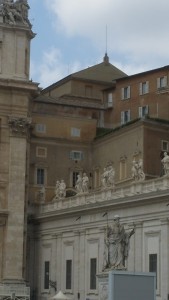
In St Peters Square there are some interesting things to observe. Just to the right of the immense (and forbidding, I think) facade of the Basilica one can just see the peak of the Sistine Chapel sticking up. It is here the faithful look to see the smoke that announces the successful election of a new pope. The colonnades, designed by Bernini, are elliptical in shape. There are two bronze disks, one on each side of the Egyptian obelisk that marks the center of the square. From each, the respective colonnades line up in perfect perspective, with only the foremost of the four deep columns visible (the other 3 lined up perfectly behind).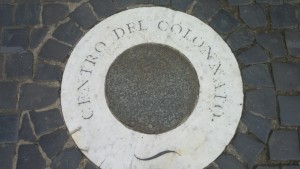
Move off the marker, and the perspective changes and one sees all 4 rows.
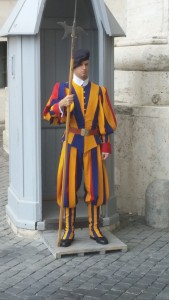 Lastly, before entering the mighty church, or upon leaving, one can photograph the Swiss Guards in their colorful traditional costumes. Contrary to popular belief, the outfits were not designed by Michelangelo. But the post of protecting the pope has been granted only to the Swiss since 1527. In that year Rome was attacked and sacked by German (Protestant) soldiers. The pope had several groups of mercenary bodyguards but only the Swiss maintained their posts and defended the pope's retreat to Castel Sant Angelo. More than half of the Swiss guards lost their lives in the skirmish. Since then, only the Swiss have been allowed to protect the pope.
Lastly, before entering the mighty church, or upon leaving, one can photograph the Swiss Guards in their colorful traditional costumes. Contrary to popular belief, the outfits were not designed by Michelangelo. But the post of protecting the pope has been granted only to the Swiss since 1527. In that year Rome was attacked and sacked by German (Protestant) soldiers. The pope had several groups of mercenary bodyguards but only the Swiss maintained their posts and defended the pope's retreat to Castel Sant Angelo. More than half of the Swiss guards lost their lives in the skirmish. Since then, only the Swiss have been allowed to protect the pope.
Inside the Basilica there is much to see beyond the "usual suspects" of Michelangelo's Pieta', Bernini's Baldacchino, and the floor markers that show where the other great churches of the world would "fit" inside St Peters. I like the large porphyry marble disk in the floor in the back of the nave that marks the spot where Charlemagne knelt to be crowned Holy Roman Emperor in the old St Peters on Christmas Day, 800 AD.
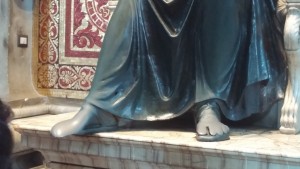 The statue of St Peter on a throne is a common sight. But I'm not sure everyone notices the bronze feet where the pious have stopped for a rub for hundreds of years. The church offers a dispensation for the act. Both feet are burnished and clearly wearing away. And they are not the originals - long ago replaced.
The statue of St Peter on a throne is a common sight. But I'm not sure everyone notices the bronze feet where the pious have stopped for a rub for hundreds of years. The church offers a dispensation for the act. Both feet are burnished and clearly wearing away. And they are not the originals - long ago replaced.
 Then there is the scale of St Peters. The dominant impression for first time visitors is how immense it truly is. Yet Bernini and others used many optical tricks to "shrink the scale" and make it seem smaller than it actually is. Take the statuary in the support piers. On first glance they appear to be of equal height. But in reality, those up near the ceiling are a full 50% larger. If they were the same as the lower statues, they would seem tiny they are so high up. Though they hoped to make the space feel smaller, nonetheless they intended for visitors to be in awe of the mother church of the universal catholic church. In that they were certainly successful.
Then there is the scale of St Peters. The dominant impression for first time visitors is how immense it truly is. Yet Bernini and others used many optical tricks to "shrink the scale" and make it seem smaller than it actually is. Take the statuary in the support piers. On first glance they appear to be of equal height. But in reality, those up near the ceiling are a full 50% larger. If they were the same as the lower statues, they would seem tiny they are so high up. Though they hoped to make the space feel smaller, nonetheless they intended for visitors to be in awe of the mother church of the universal catholic church. In that they were certainly successful.

